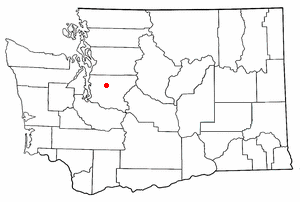Fall City, Washington
|
|
Fall City is an unincorporated town located 26 miles east of Seattle in King County, Washington along the Snoqualmie River. As of the 2000 census, the CDP had a total population of 1,638. The Fall City Airport is a small private airport community located roughly 1 mile east of the town.
| Contents |
History
The first settlements in the area were two forts built in 1856 to protect future settlers against possible uprisings by the native population. Fort Patterson, a few miles downstream, and Fort Tilton, a few miles upstream, were both abandoned within 2 years after interactions with the local tribes remained peaceful. A historical marker can be found north of Fall City on the Fish Hatchery Road where Fort Tilton once stood.
A trading post was established near the present day location of the Last Chance Saloon in 1869 and became a hub of the local economy. Fall City was known at the time as "The Landing", as shallow water and rapids upstream on the Snoqualmie were impassable to the large dugout canoes used for transporting goods. In the early 1870s the first local mill in the Snoqualmie Valley was opened at the mouth of Tokul Creek, just downstream from Snoqualmie Falls and just upstream from where Fall City would be. The Fall City Post Office first opened June 10, 1872.
The first small steamboats started ferrying supplies up the river in 1875. In the late 1880s, a group of Puget Sound businessmen founded and started building the Seattle, Lake Shore & Eastern railroad including a line up into the upper Snoqualmie valley, in an attempt to build a line over the Cascade range. The land claim holder at the time, Jeremiah "Jerry" Borst, had Fall City surveyed and platted in anticipation of the people the railroad would bring, but was disappointed in 1889 when the railroad line was built a mile away from the town.
However even a mile away the railroad combined with the first bridge over the Snoqualmie River greatly improved the business of the local lumber mills and farmers, and made the area and its scenic features (such as Snoqualmie Falls) accessible to tourists. Hundreds moved to the area over the next two decades.
When the Sunset Highway, connecting Seattle with eastern Washington through Fall City was improved in the early 1910s, it further accelerated the economic and residential development of the area. Fall City was easier than ever to reach with the availability of inexpensive cars like the Ford Model T. By the late 1920s most of the population either worked in the bourgeoning tourist trade or commuted to work west toward Issaquah and Seattle.
The Great Depression followed by gasoline rationing during World War II hurt the tourist trade in Fall City. And tourism was further hampered just after the war as U.S. Highway 10 (now Interstate 90) was rerouted south directly from Preston to North Bend, bypassing Fall City and Snoqualmie. The local economy suffered further impacts as the local logging mills started closing.
Today, Fall City is a bedroom community to the high tech industry of the Seattle metropolitan area with large suburban estates just outside of the town juxtaposed with the historical homes and farmsteads built in the town's heyday.
Geography
Fall City is located at 47°33'59" North, 121°53'42" West (47.566419, -121.894972)Template:GR.According to the United States Census Bureau, the CDP has a total area of 3.4 km² (1.3 mi²). 3.4 km² (1.3 mi²) of it is land and none of the area is covered with water.
The town sits at the confluence of the Snoqualmie River and the Raging River and is sometimes, albeit rarely, subject to flooding during the autumn months.
Demographics
As of the censusTemplate:GR of 2000, there are 1,638 people, 644 households, and 473 families residing in the CDP. The population density is 482.8/km² (1,253.5/mi²). There are 649 housing units at an average density of 191.3/km² (496.6/mi²). The racial makeup of the CDP is 94.44% White, 0.24% African American, 0.92% Native American, 0.73% Asian, 0.00% Pacific Islander, 1.40% from other races, and 2.26% from two or more races. 2.63% of the population are Hispanic or Latino of any race.
There are 644 households out of which 33.9% have children under the age of 18 living with them, 58.9% are married couples living together, 8.5% have a female householder with no husband present, and 26.4% are non-families. 19.7% of all households are made up of individuals and 7.8% have someone living alone who is 65 years of age or older. The average household size is 2.54 and the average family size is 2.91.
In the CDP the population is spread out with 25.1% under the age of 18, 5.7% from 18 to 24, 32.0% from 25 to 44, 25.1% from 45 to 64, and 12.1% who are 65 years of age or older. The median age is 40 years. For every 100 females there are 104.0 males. For every 100 females age 18 and over, there are 99.2 males.
The median income for a household in the CDP is $61,848, and the median income for a family is $68,529. Males have a median income of $42,325 versus $32,143 for females. The per capita income for the CDP is $25,189. 4.1% of the population and 2.4% of families are below the poverty line. Out of the total population, 2.7% of those under the age of 18 and 3.9% of those 65 and older are living below the poverty line.

